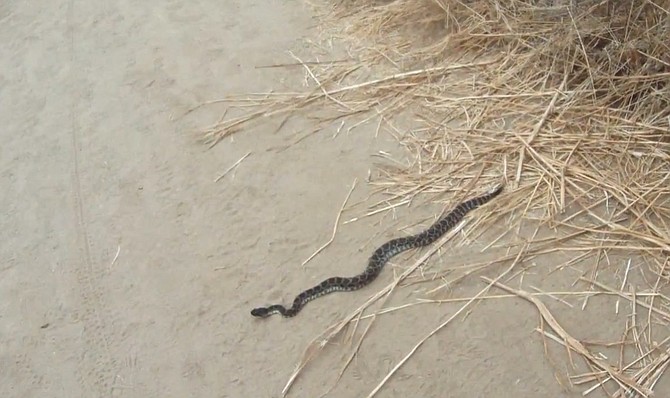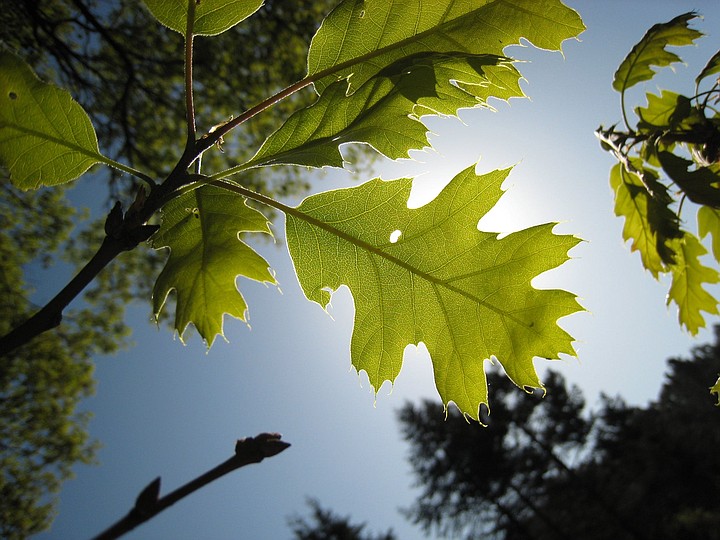 Facebook
Facebook
 X
X
 Instagram
Instagram
 TikTok
TikTok
 Youtube
Youtube

Snakes, encouraged by recent warm temperatures, have already emerged from burrows and rock crevices to hunt for prey throughout the county’s lower-elevation hillsides and canyons. Gopher snakes, garter snakes, king snakes, rosy boas (all harmless), and three varieties of rattlesnakes — red diamond, speckled, and Southern Pacific rattlesnakes (all poisonous) — are typically sighted this time of year. Close encounters with rattlesnakes are not uncommon wherever residential properties abut undeveloped land — a common situation in much of San Diego County.

The Black Oak, San Diego County’s most handsome native deciduous tree, is sending out new leaves this week, painting the mountain slopes with shades of red, brown, and bright green. The newly emergent leaves are reddishbrown in color, creating a pseudo-autumn color in the forest. After a week or two the unfolding leaves acquire a light green tint; after a month they’re dark green. Black oaks are common throughout the upper elevations of the Palomar, Cuyamaca, and Laguna mountains. Enjoy the show by exploring either the Fry Creek or Observatory trails on Palomar Mountain. Both begin at the national forest campground area two miles below Palomar Observatory.
The Annual Green-to-Golden Transition of San Diego’s wild grasslands typically starts during early April — though this year the green phase will likely stick around for two more weeks because of the past winter’s abundant rainfall. North-facing hillsides and canyon slopes retain the green color longer, as they are less exposed to drying sunshine. Locally, most of the wild grasses are naturalized (non-native) annuals, the seeds of which were introduced along with hay and other grains brought in by the Spaniards during the 18th and 19th Centuries. Some of the mountain meadows have remnants of native grasses, which remain more or less green almost the year round. These rare native grasslands can be found in certain parts of Cuyamaca Rancho State Park and more widely distributed at the Santa Rosa Plateau Ecological Reserve in the Santa Ana Mountains west of Temecula.
The above comes from the Outdoors listings in the Reader compiled by Jerry Schad, author of Afoot & Afield in San Diego County. Schad died in 2011. Planet information from SkyandTelescope.org.


Snakes, encouraged by recent warm temperatures, have already emerged from burrows and rock crevices to hunt for prey throughout the county’s lower-elevation hillsides and canyons. Gopher snakes, garter snakes, king snakes, rosy boas (all harmless), and three varieties of rattlesnakes — red diamond, speckled, and Southern Pacific rattlesnakes (all poisonous) — are typically sighted this time of year. Close encounters with rattlesnakes are not uncommon wherever residential properties abut undeveloped land — a common situation in much of San Diego County.

The Black Oak, San Diego County’s most handsome native deciduous tree, is sending out new leaves this week, painting the mountain slopes with shades of red, brown, and bright green. The newly emergent leaves are reddishbrown in color, creating a pseudo-autumn color in the forest. After a week or two the unfolding leaves acquire a light green tint; after a month they’re dark green. Black oaks are common throughout the upper elevations of the Palomar, Cuyamaca, and Laguna mountains. Enjoy the show by exploring either the Fry Creek or Observatory trails on Palomar Mountain. Both begin at the national forest campground area two miles below Palomar Observatory.
The Annual Green-to-Golden Transition of San Diego’s wild grasslands typically starts during early April — though this year the green phase will likely stick around for two more weeks because of the past winter’s abundant rainfall. North-facing hillsides and canyon slopes retain the green color longer, as they are less exposed to drying sunshine. Locally, most of the wild grasses are naturalized (non-native) annuals, the seeds of which were introduced along with hay and other grains brought in by the Spaniards during the 18th and 19th Centuries. Some of the mountain meadows have remnants of native grasses, which remain more or less green almost the year round. These rare native grasslands can be found in certain parts of Cuyamaca Rancho State Park and more widely distributed at the Santa Rosa Plateau Ecological Reserve in the Santa Ana Mountains west of Temecula.
The above comes from the Outdoors listings in the Reader compiled by Jerry Schad, author of Afoot & Afield in San Diego County. Schad died in 2011. Planet information from SkyandTelescope.org.
Comments